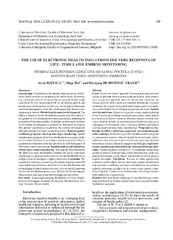Please use this identifier to cite or link to this item:
https://rfos.fon.bg.ac.rs/handle/123456789/1892| Title: | Primena elektronskog zdravstva od samog početka života - kontinuirani video monitoring embriona The use of electronic health tools from the very beginning of life: Time-lapse embryo monitoring |
Authors: | Bjelica, Artur Šoć, Maja Despotović-Zrakić, Marijana |
Keywords: | time-lapse imidžing;in vitro fertilizacija;embriotransfer;embrionalni razvoj;bezbednost pacijenta;asistirane reproduktivne tehnike;time-lapse imaging;reproductive techniques, assisted;patient safety;fertilization in vitro;embryonic development;embryo transfer | Issue Date: | 2019 | Publisher: | Društvo lekara Vojvodine Srpskog lekarskog društva, Novi Sad | Abstract: | Uvod. Pored vec' široke upotrebe elektronskih zdravstvenih usluga za prac'enje zdravstvenog stanja pacijenata, treba pomenuti i moguc'nost upotrebe alata za elektronsko zdravstvo od samog početka života odnosno prac'enja formiranja i razvoja embriona. Na ovaj se način pojam elektronskog zdravstva proširio na čitav ljudski život, od njegovog početka do kraja. Nadzor razvoja embriona. Napor da se povec'a stopa uspeha oplodnje in vitro prac'en je uvođenjem različitih postupaka, među kojima je i procena kvaliteta embriona. Detaljan nadzor kinetike razvoja embriona postiže se laboratorijskim tehnikama kojima se omoguc'ava kontinuirani uvid u razvoj embriona primenom sistema kontinuiranog video-monitoringa. Programi za evaluaciju kvaliteta embriona zasnovani na kontinuiranom video-nadzoru. Kreirani su posebni bioinformatički programi za automatsku analizu slika dobijenih kontinuiranim videonadzorom koji omoguc'avaju kvantitativnu procenu ključnih trenutaka u razvoju embriona i njegove morfologije. Implementacija i ograničenja kontinuiranog video monitoringa embriona. Vec'ina eksperata u oblasti in vitro oplodnje smatra da je primena sistema kontinuiranog video-monitoringa veliki napredak tehnologije u ovoj oblasti koja dovodi do vec'EG stepena uspeha postupka. Zaključak. Sistemi za video-monitoring embriona predstavljaju moc'ne alate koji pomažu kliničarima koji sprovode vantelesnu oplodnju i embriolozima da odaberu najbolje embrione, sa ciljem da se povec'a stopa uspeha vantelesne oplodnje. Uprkos svim prednostima, ovi sistemi imaju i neke nedostatke i ograničenja. Introduction. In addition to the already widespread use of electronic health services in monitoring the health status of patients, one should also refer to the possibility of using electronic health tools from the very beginning of life by monitoring growth and development of the embryo. In this way, the concept of electronic health would expand to cover the whole human life, from its very beginning to the end. Monitoring the embryo development. The efforts to improve in vitro fertilization success rate have been accompanied by the introduction of various procedures, including the evaluation of the embryo quality. A detailed monitoring of the kinetics of embryo development is achieved by laboratory techniques that provide continuous insight into the embryo development through applying time-lapse monitoring system. Embryo quality evaluation programs based on time-lapse monitoring. Special bioinformatic programs have been developed for automatic analysis of images obtained by time-lapse monitoring which allow a quantitative evaluation of the key moments in the development of the embryo and its morphology. Implementation and limitations of time-lapse embryo monitoring. The majority of authorities in the field of in vitro fertilization consider the use of time-lapse monitoring as a great advancement in the in vitro fertilization technology, obviously leading to a higher success rate. Conclusion. The systems for time-lapse monitoring of embryos represent powerful tools which help clinicians involved in in vitro fertilization and embryologists to select the best embryos, with the aim of improving the in vitro fertilization success rate. Despite all the advantages, these systems also have some shortcomings and limitations. |
URI: | https://rfos.fon.bg.ac.rs/handle/123456789/1892 | ISSN: | 0025-8105 |
| Appears in Collections: | Radovi istraživača / Researchers’ publications |
Show full item record
Items in DSpace are protected by copyright, with all rights reserved, unless otherwise indicated.

